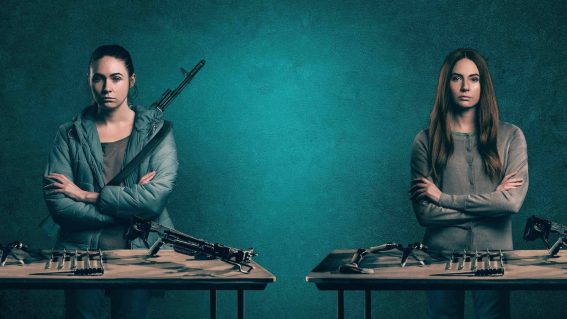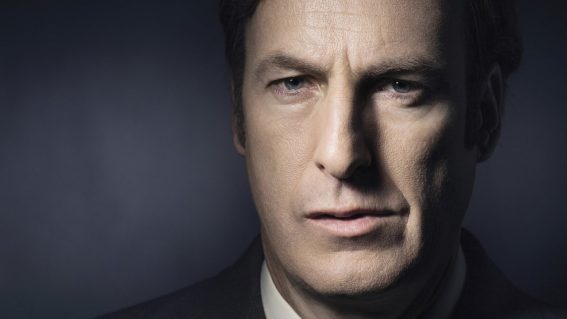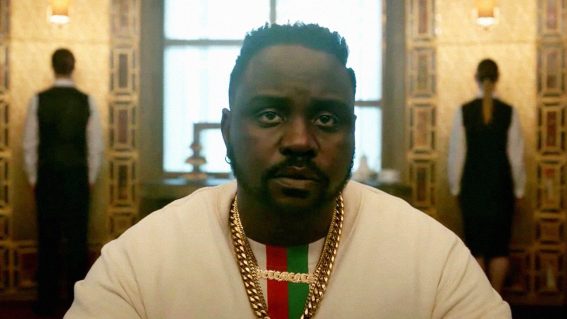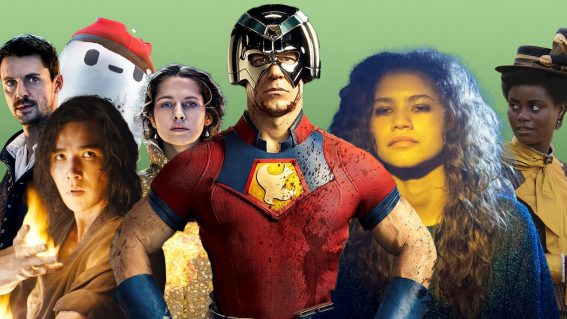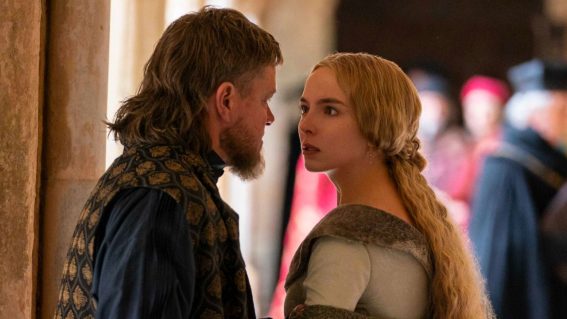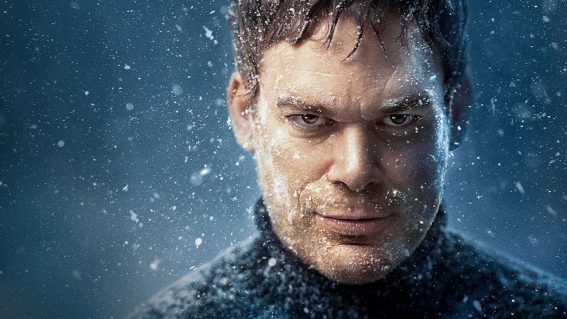As the final episodes of Vikings arrive, here’s why it’s been such great viewing
13 reasons to love this heady mix of brutal action, romance, and drama.
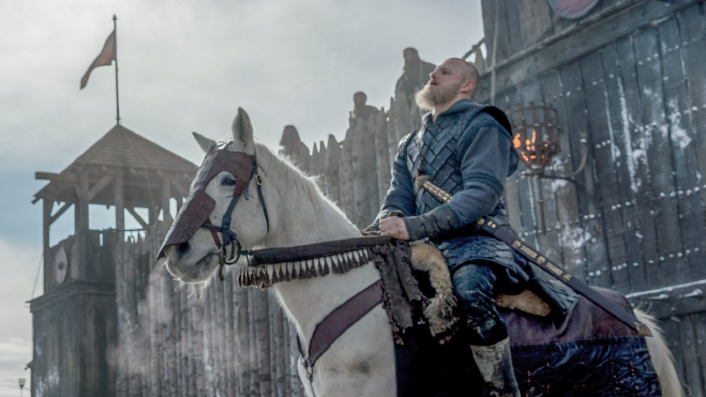
The final ever episodes of action-packed series Vikings have begun streaming on Neon. Longtime fan Adam Fresco is here with 13 reasons why he’s loved this heady mix of brutal action, romance and drama.
WARNING: If you are reading this and you’re new to historical drama series Vikings, then there are two things you need to know. One, this being an overview of six seasons of historical drama, there are likely spoilers ahead, and two—you are in for a bingeworthy TV treat!
See also
* Films and shows now streaming on Neon
* Everything coming to Neon in December
Vikings had me hooked from the start, when the Irish-Canadian co-production made its debut in 2013. Showrunner Michael Hirst, the creator and a regular writer on the series, stuck by his horny-hatted baby through six seasons, shooting largely in Ireland. Mixing adventure, mysticism, action, brutal battles, romance, and family drama, Vikings is a lot like a certain fantasy series involving Games and Thrones, only ripped from reality.
Or, at least, from Thirteenth-Century sagas relating the exploits of early medieval Scandinavian Norsemen, the legendary Ragnar Lothbrok and his sons. These stories, passed down by word of mouth, are potent blends of historical facts, fabulous fantasy, politics and poetry, gods and monsters, faith and folklore, heroes and villains, kings, queens, and conquests, feuding families, fighting brothers and bloody betrayal.
1. That Theme: Fever Ray’s ‘If I Had a Heart’
After six seasons, the theme from Vikings is a mainstay on my Spotify playlist. ‘If I Had a Heart’ by Swedish artist Fever Ray, with its pulsating bass tones and moody, dark refrain of “More, give me more, give me more,” is a perfect summation of the grim, gritty, and power-grabbing world of medieval mysteries and mayhem. The one thing any great theme needs is repeatability, and ‘If I Had A Heart’ ranks as one of those few series-opening songs that you won’t need to fast-forward through. Instead, it has become for me a song that says, sit back, relax, and get ready to take a ride in a Viking longship.
Watch the opening credits:
2. That Star Turn: Travis Fimmel as Ragnar Lothbrok
Australian-born model turned actor Travis Fimmel sizzles in every scene. As Ragnar Lothbrok, the young farmer who rises to become a legendary Viking King, he pretty much owns every season he’s in. Why? Well, the role allows his charisma, charm, twinkling eyes, off-kilter sense of humor and amazingly hot good looks to shine. True story (and by true, I mean I read it on the internet…), when Fimmel featured on a central London billboard, advertising Calvin Klein underwear, traffic apparently became so congested in the area with drivers besotted by Fimmel’s frame, the billboard had to be removed. Seriously.
After being one of the most in-demand male models in the world, Fimmel played a range of roles in film and television before landing his legendary lead role in Vikings. Starting as a humble farmer, Ragnar begins frustrated by his local chieftain’s lack of daring, and with his secret weapon of an early compass, sets out to pillage new lands beyond the Scandinavian seas. It’s hard to imagine anyone else in the role of Ragnar. Fimmel truly made it his own, from his strutting bravura in battle, to his greed for treasure, desire for power, and his wonderfully understated sense of humour, Fimmel’s Ragnar is as essential to the first few seasons of Vikings as Bryan Cranston was for Breaking Bad.
Since leaving the series, Fimmel has featured in a few Hollywood star vehicles that failed to fire completely, including lead roles in the movie Warcraft, Danger Close: The Battle of Long Tan, and opposite fellow Aussie Margot Robbie in Dreamland, as well as Ridley Scott’s sci-fi series Raised by Wolves.
Oh, and it turns out Fimmel is a George Clooney-level prankster on set, too. Take a look at his antics in this peek behind the scenes of the making of the show:
3. That Usual Suspect: Gabriel Byrne as Earl Haraldson
Starting with the dawn of the Viking Age, the series kicks off with young Norse farmer Ragnar Lothbrok discovering an early form of compass. Ragnar seeks adventure, but locks horns with his less-than-adventurous chieftain, Earl Haraldson. Lording over the small seaport of Kattegat, in what is today Norway, the Earl is played by Irish-born actor, Gabriel Byrne, giving a great star turn. His Earl is a fearsome warrior, much respected for past deeds but grown old and surrounded by enemies—ever more paranoid, and rightly so, following the brutal murder of his two sons. No wonder he’s so grim, publicly rejecting Ragnar’s suggestion they raid the lands to the West, then privately threatening the young upstart for challenging him.
Earl is a man-made cruel by circumstance, but he certainly recognises Ragnar’s threat as a young warrior hungry for, in the words of the title song: “More, more, more.” Behind his Earl’s back, Ragnar has his mate Floki build a new type of longship, enabling Ragnar and friends to raid new lands to the West, returning home with plunder aplenty. No longer able to deny the existence of this new world of opportunity, The Earl is furious at Ragnar’s refusal to heed his orders, and confiscates Ragnar’s treasure hoard. No spoilers for what’s in store for Earl Haraldson in season one, but let’s just say he has something in common with Sean Bean in Game of Thrones…
Check out Byrne’s best bits as The Earl of Kattegat:
4. That First Raid: Lindisfarne, 793 AD
With a compass to navigate by, Loki to build better longships, and having the ambition to seek new lands to pillage, Ragnar’s journey from farmer to great warrior begins. Defying his local chieftain, The Earl, Ragnar and his crew of Vikings sack the early Christian settlement on the island of Lindisfarne, just off the northeast coast of Britain. Torn from the history books, the Viking raid of 793 AD is depicted in all its savage fury, as the brutal male and female Viking warriors decimate the Christian settlement, murdering the monks, and stealing the treasures of their church. More importantly for Vikings fans, this is where they kidnap the monk Athelstan, who will later go from being Ragnar’s prisoner to his friend and trusted councillor.
Watch this clip of Ragnar’s Viking hordes raiding Lindisfarne:
5. That Monk: George Blagden as Athelstan
Kidnapped by Vikings from his quiet life of monastic devotion, Athelstan (played by George Blagden) is one of the most interesting and complex characters in the series. He starts as a devout Christian, is dragged off to become a slave, raised in Viking ways, and ends up torn between his newfound home and his now-fractured faith. A man of letters, Athelstan is quickly recognised by Ragnar as having important insights into the Anglo-Saxon world, and its rich library of historical and geographical knowledge. Sensing a tactical advantage, and eager to learn more, Ragnar increasingly seeks Athelstan’s counsel, until the two become friends, and some series fans might argue, maybe even more…
In fact, some fans have gone as far as to celebrate their bromance in tribute videos:
Whatever you make of their friendship, it’s not hard to see why Ragnar’s long-time Viking pal Floki takes offense at the intrusion of someone into Ragnar’s inner circle who not only questions the Norse gods of old, but the Vikings’ very way of life. Faith versus freedom, old gods versus new, saintliness versus sexuality—Athelstan’s character embodies a whole heap of contradictory impulses, serving as an excellent bridge between Viking tradition and the new Christian condition.
Take a look, for example, at this scene from season two, where Linus Roache, as the King of Wessex (a kingdom in the yet-to-be-united kingdom of Britain), discusses Paganism with Athelstan:
6. That King: Linus Roache as King Ecbert
King Ecbert, King of Wessex, is trustworthy as a viper, ambitious to the point of full-on sociopathy, and a villain played with such panache he’s one you’ll love to hate. As he himself admits, “I would sup with the devil if he would show me how to achieve my earthly goals”. See? He even talks like a Shakespearian villain, and in the role Linus Roache channels everything from the Bard of Avon’s Iago, through Macbeth, to Richard III, in his creation of a character that makes being bad his order of business.
You might recognise Roache, the son of UK actor (and Coronation Street) staple William Roache. Linus featured in TV dramas Law and Order: SVU and Homeland, played Robert Kennedy in RFK, and had roles in both the movies Batman Begins and—most revealing of all—as the bonkers cult leader up against Nicolas Cage in the mind-melting Mandy.
More Machiavellian than madman, Roache imbues Ecbert with intellect, ambition, and a merciless desire to see his country united as one nation, under one King. His friendship and admiration with the invading Viking leader, Ragnar, is pivotal in the show, and tragic for Ragnar’s ultimate future.
Watch Ecbert talk strategy with Ragnar in this clip from Season Three:
7. That Sheild-maiden: Katheryn Winnick as Lagertha
Wife, mother, shield-maiden, warrior, and queen, as played by Katheryn Winnick, Lagertha kicks some serious ass throughout her six-season stint on Vikings. Brave, intelligent, a brilliant tactician and vicious warrior, Lagertha is both complex and convincing in her devotion to her family, her people, and to protecting the Viking way of life.
At the start of the series, she is married to Ragnar, remaining by his side, as warrior and mother, soulmate and best friend, long after their marriage ends. Raised from childhood as a shield-maiden, (women chosen to fight alongside male warriors in Scandinavian folklore and mythology), Winnick breathes total believability into Lagertha’s fearsome fighting agility, her deep love as a mother for her children, and her independence as a woman, lover, queen, and warrior, serving only the gods and resigned always to the Viking belief of victory or Valhalla.
Check out Lagertha’s epic (and spoilerific) fight from Season Six:
8. That boatbuilder, warrior and mystic: Caspar Orm Skarsgård as Floki
Floki is a boat builder and warrior, who believes absolutely in the Norse gods, and in the Viking way of life and death. For many seasons, Floki is Ragnar’s most trusted and loyal friend who designs better and faster longboats, enabling Ragnar to invade the newly discovered lands to the West. It is Floki who more than once in the series invents new, formidable weapons of war, even finding ways to move an entire fleet over a mountain in one gloriously (and literally) over-the-top episode.
As portrayed by Swedish actor Gustaf Caspar Orm Skarsgård (one of the many talented actor sons of Stellan Skarsgård), Floki is a quirky, comedic, brilliant, unpredictable, violent, and deeply spiritual character. From confidant and advisor to drinking buddy and formidable fighting ally, Floki is always at Ragnar’s side and remains loyal to the sons of Ragnar throughout. But for Loki, Ragnar goes too far when he befriends the Christian monk, Athelstan, renouncing the Norse gods Floki holds in such high regard.
Betrayed by Ragnar, Floki sails away on a voyage of discovery, only to find Asgard, the home of the Norse gods. Actually, it turns out to be a less than hospitable Iceland which Loki finds, and establishes a settlement with fellow Vikings he convinces to join him. But what starts out as Floki’s idealised Viking utopia, quickly descends into a vengeance-ridden hell.
Check out Floki’s discovery of the island he believes to be Asgard in this clip from Season Five episode, ‘The Departed’:
9. That Seer: John Kavanagh as The Oracle
The Seer, played beneath mounds of lumpy latex by John Kavanagh, is known as the Oracle of Kattegat. His face horribly deformed, we know not how, he possesses supernatural powers, allowing him to see into the future. Pretty handy, because at the core of Viking belief was that their fate was predetermined, the outcome decided long ago by the gods. Free will is a luxury Vikings did not ascribe to, instead seeking the advice of The Seer, and of omens and portents, rituals and sacrifices to determine the path they are fated to follow. The Seer connects Vikings to the spiritual world of gods, the dead, and the yet to be born. It’s hinted in the show that The Seer may be hundreds of years old, and perhaps even a god himself, or maybe just a mortal high as a kite, experiencing hallucinated visions, which he interprets as messages from the gods.
Either way, his words are often deep, and deeply ambiguous, open to interpretation, but always, in retrospect, bang on the nail. He can be seen consulting key characters throughout the first five seasons, and it’s only when you look back that you fully understand the implications of his words and visions. Take for example his prediction that Ragnar will “die on the day that the blind man sees you”. Deep. But what the hell it means is not clear until you have watched several seasons.
Check out this scene in which Ragnar consults The Seer in Season Two:
10. That Scenery-Chewing Norwegian King: Steven Berkoff as Olaf the Stout
Joining Vikings for its final two seasons, British actor Steven Berkoff plays Norwegian King Olaf The Stout. Berkoff is an actor known for his roles in classic movies ranging from Kubrick’s A Clockwork Orange to the big bad in Prince’s Under the Cherry Moon, and Stallone’s Rambo: First Blood Part II. Better known in Europe as the bad boy of 1980s British theatre, Berkoff wrote and directed plays with a punk sensibility, from the profanity-heavy East and West, to his outrageous modern re-telling of Oedipus in Greek, and his dynamic stage-adaptations of Franz Kafka’s The Trial and Metamorphosis, Berkoff does not do things by half. In fact, judging by the belly on him as King Olaf, he’s been eating more than just the scenery.
Berkoff’s Olaf is a King given to Machiavellian machinations, power plays, deviousness, torturing his foes (only to become their friend and ally when it suits), wearing an outrageous array of giant earrings, and making big (and I really do mean BIG) speeches. Try this one, from Season Six episode ‘Ragnarök’, in which Berkoff gets to yell his “Come and see!” speech mid-battle. A speech that goes like this:
“Come and see! Come and see the death of humanity, upon a shore of corpses, broken heads, spilled guts, scorched flesh! Come and see the young tearing each other’s throats out! Rivers of poison will flow through the halls! Oathbreakers, philanderers, murderers will wade through those rivers! Come and see! Come and see!”
Watch Berkoff grandstand the speech, in all its bonkers glory:
11. That New Star Turn: Alex Høgh Anderson as Ívarr The Boneless
Following Ragnar’s exit from the show, there was a huge Travis Fimmel-shaped hole left in Vikings, with no obvious character set to star alongside Katheryn Winnick as the awesome Viking Queen, Lagertha. A few uncertain episodes followed Ragnar’s departure, but that wobble was soon set right by the meteoric rise of Ragnar’s son, Ívarr. Known as “The Boneless”, Alex Høgh Andersen owns the character of Ívarr, a proud Viking who, despite having no use of his legs and no feelings beneath his waist, overcomes his physical paralysis with sheer bloody determination and force of will. The actor powers his way through entire seasons, propelled only by his biceps and ambition for revenge and glory.
Vicious and fascinating, power-hungry yet sympathetic, Ívarr is a warrior who makes up for his paralysis by turning his Viking up to eleven. In one episode he kills Sigurd, one of his brothers, over a silly slight. In another, he slaughters the woman he supposedly loves. In another, he burns a girl who looks like Lagertha, the Viking Queen who murdered his mother. As Ragnar’s youngest son, Ívarr has much to prove, and his journey in the series takes him from mocked cripple to tyrannical King of Kattegat, crazed by his desire for revenge, and then his eventual exile and return from the wintry lands of Russian Vikings. Portrayed as a man-made monster by the pain of his physical condition and his treatment by others as an outsider, Ívarr is yet another complex and compromised character in a world rich with villains made mortal by their all-too-human failings.
Watch Ívarr come face to face for the first time with his nemesis, Bishop Heahmund (Jonathan Rhys Meyers), in their Season Five battle of the bastards:
12. That Bloody Bishop: Jonathan Rhys Meyers as Heahmund
Jonathan Rhys Meyers plays sword-wielding warrior-Christian Bishop Heahmond. Based on the real-life historical figure, Heahmond is a Saxon holy warrior who arrives in season five to take on the heathen Vikings, only to fall for Norse queen, Lagertha. A brilliant fighter, Meyers deftly portrays Heahmond’s character arc, from cocky, hypocritical, religious swashbuckler to crisis of faith Viking protector.
A complex and intriguing figure, meet the warrior Bishop in History Channel’s introduction to Heahmond:
13. That Bloody Eagle
When it comes to gruesome death scenes, Vikings was slow to catch up on Game of Thrones‘ gory start—but when they did unleash the special make-up effects, they did so with buckets of stage blood and a wheelbarrow full of prosthetic limbs. Take the “Blood Eagle”, a brutal ritual slaughter involving cracking open your enemies’ rib-cage from the back, then opening them up, with their lungs slung their shoulders to look like wings.
Think Hannibal only less gastronomically delectable. So, if you can stomach it, here’s Ragnar dealing with his enemy Jarl Borg in Season Two:
And, from Season Four, here’s Ragnar’s sons taking Blood Eagled revenge on Aelle, the English King who introduced Ragnar to a pit of snakes:
________________
Thirteen reasons to watch Vikings , and I’ve not even mentioned Ragnar’s brother Rollo, or Ragnar’s sons Bjorn “Ironside” and Ubbe, the characters Torvi or Siggy, Harald Finehair, Aethelwulf, Ray Stevenson as Othere, or Kevin Durand as the mysterious and possibly divine wanderer, Harbard, nor a host of others all worthy of praise.
So, yeah, Vikings is a six-season show well worth your time. For me, what started as an interesting show to watch between weekly episodes of Game of Thrones, quickly became a must-see in its own right. As for how historically accurate it is? I’ll leave that to historians to argue over, but as for how addictively entertaining a medieval soap opera it is, complete with battles, romance, intrigue, political shenanigans, and family feuds, I can attest to being a horn-hatted fan.







